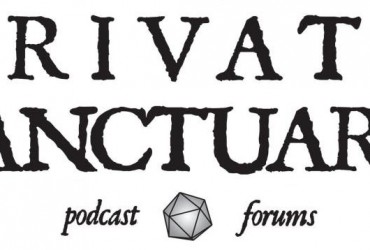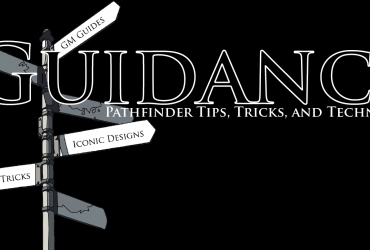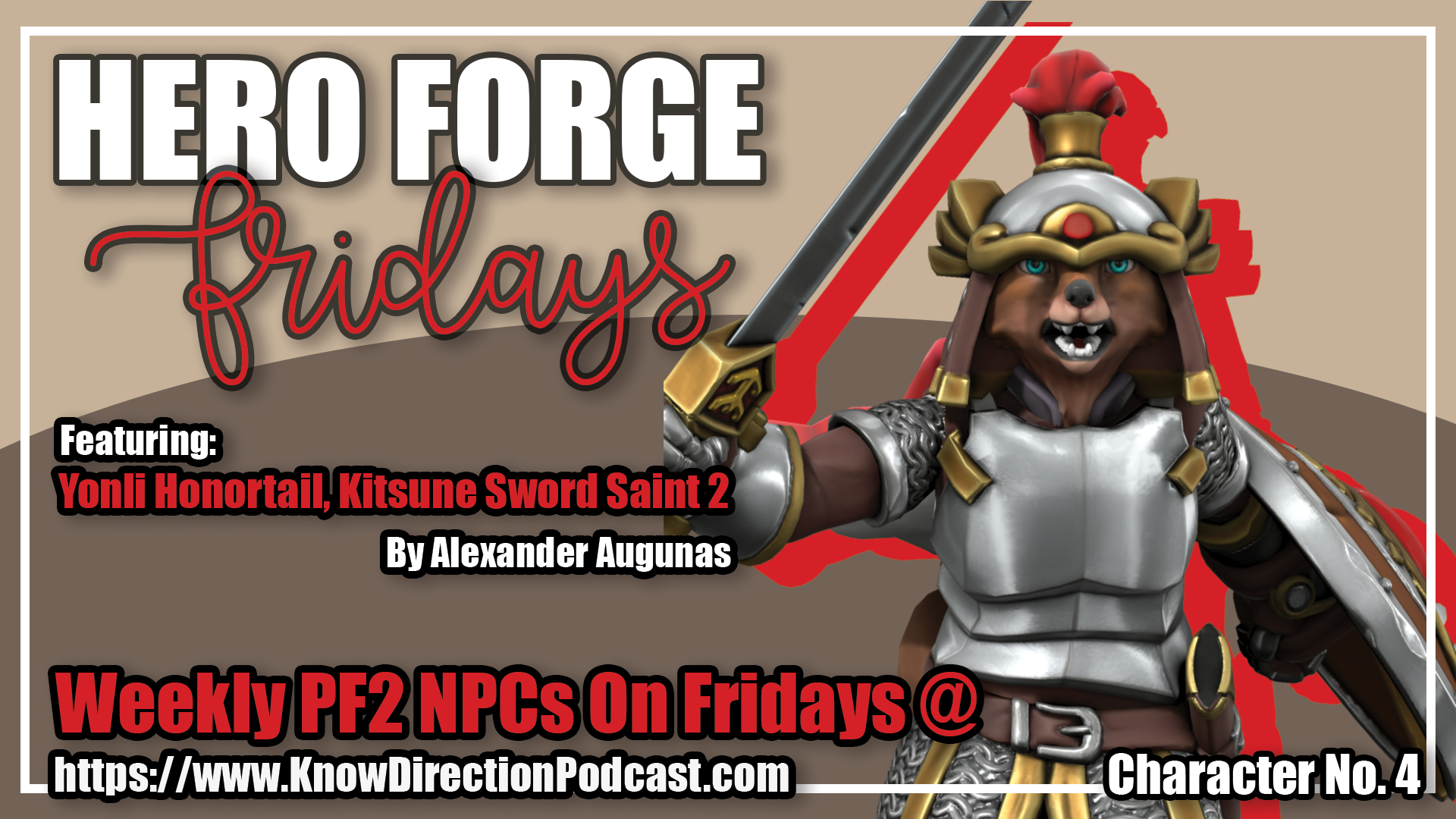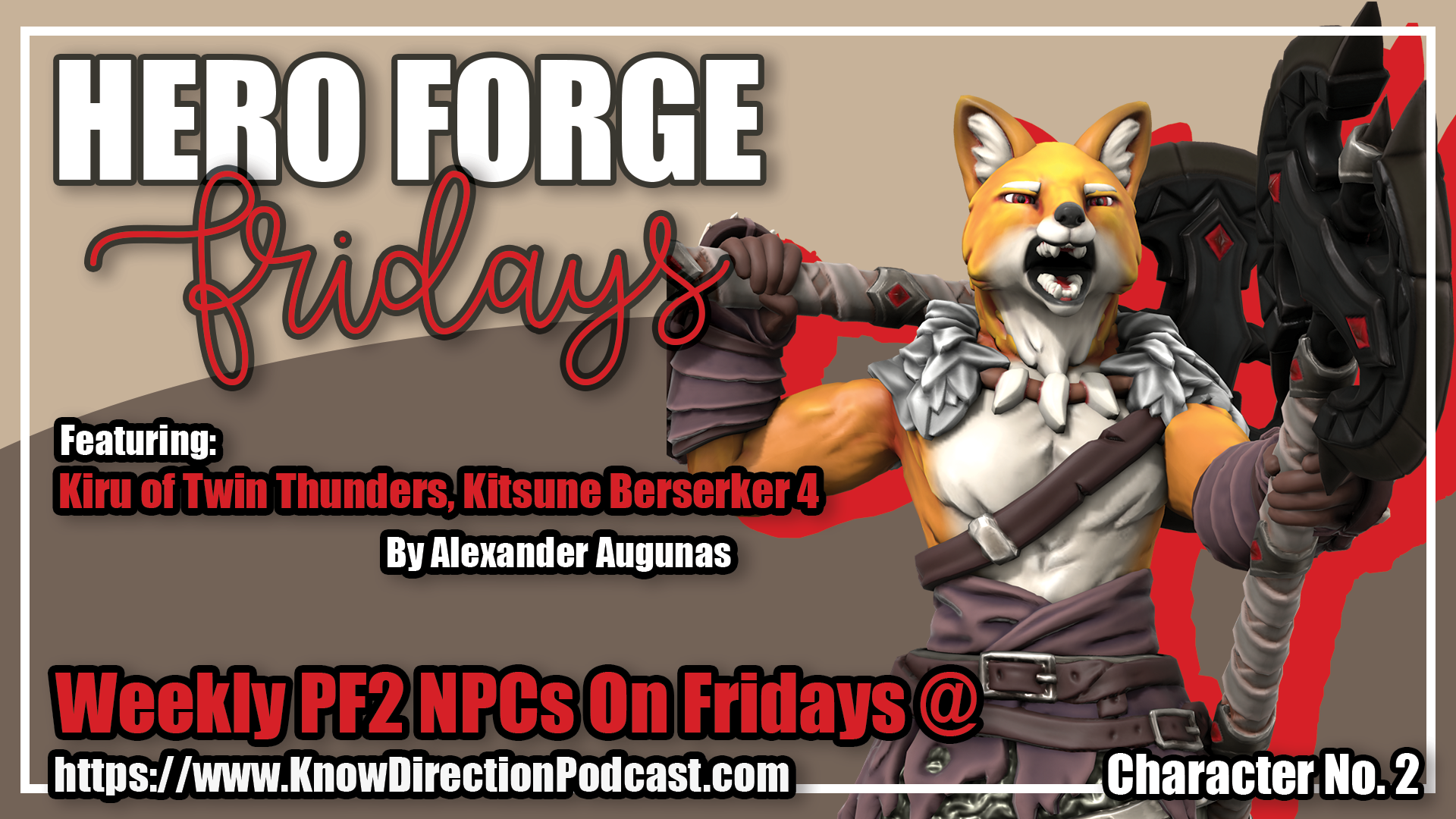Welcome to Guidance, Private Sanctuary’s source for tips and techniques for the Pathfinder Roleplaying Game, written by Everyman Gamer Alexander Augunas. Today, we’re going to be looking at an arcane trickster build.
As a result of this FAQ clarification, this build does not work as written. The ability for spell-like abilities to meet the prerequisites of prestige classes and feats that required the ability to cast spells of a certain level was abolished on February 18th, 2015, rendering this build impotent. Sorry for any confusion or inconvenience. – Alex
Before Christmas, one of my readers asked me if I would do an arcane trickster build on Iconic Design. Whenever someone asks me to do a build for them, I always do my best to oblige but I need to be honest, folks: I hate the arcane trickster prestige class. It is the epitome of a prestige class that doesn’t know what it wants to be good at. It boosts sneak attack damage, but it does the bare minimum in trying to help you actually land sneak attacks against your foes. It provides a full boost to your arcane caster level, but it doesn’t do anything to boost any of the cool special abilities that you get from your class. To top it all off, every level feels wanting, like the class is divided in trying to be a tricky mage and a sneak attack mage, and no one level ever really feels like it gives you enough. To say that I don’t like this prestige class would be an understatement.
But I digress; I’m going to do everything in my power to help my reader make a somewhat effective arcane trickster build. Let’s get to it.
Build Concept
So the basic problem that we have with arcane trickster is the stark polarization in its class features. Most of the class seems designed to help you pull off the rogue’s burst damage tactics with spells, but then you realize that this prestige class inherits the wizard’s poor base attack bonus. Combined with the fact that spell + sneak attack is almost never going to do as much damage as iterative melee attacks + sneak attack and you have a combination that doesn’t really help you much. The wizard’s base attack bonus will ensure that you never hit with melee weapons while the various spell mechanics will ensure that you won’t come close to outdamaging a rogue. (Sad, isn’t it?) To top all this off, the class has VERY strict multiclassing requirements, ones that will really hurt any spellcaster trying to enter the class. Luckily, there are some things that we can do in order to get into the arcane trickster class as soon as possible.
- Wizard: First, I’m opting to pick the wizard class for our arcane spellcasting class. We’re already going to be three levels behind in spellcasting through multiclassing, and we don’t need to be a fourth level behind by choosing arcanist or sorcerer. Also, the wizard has fewer powers that are dependent on his level, which will make it easier than, say, going sorcerer and being constantly reminded of how our bloodline powers aren’t going to scale at all. For our school, I’m choosing admixture. This school allows you to be extremely flexible with the damage type of your spells, which will be helpful because this is the only way that we’re ever going to come close to sneak attacking.
- Rogue: My entry-level build is basically a rogue build: rogue 3 / wizard 1. I opted for three levels of rogue on my path for sneak attack instead of, say, wizard 2 / brawler (snakebite striker) 1 / rogue 1 for one simple reason: I really want offensive defensive. This amazing rogue talent will give you a +1 dodge bonus per sneak attack die you roll against a target, making it invaluable for a squishy mage such as yourself. Getting a decent armor class is going to be imperative if you want to do any sort of sneak attacking.
- Race: Now, the final thing we have to decide is our character’s race, which is VERY important to this build. Essentially, in order to take arcane trickster at Level 5 we need to make sure that we can cast a 2nd-level spell, and in order to pull that off as a wizard 1 / rogue 3, we need to belong to a race that gives us a 2nd-level or higher spell-like ability. Here are our choices: aasimar, duergar, drow, svirfneblin, or tiefling. Since no GM is EVER going to allow you to be a svirfneblin, that really leaves aasimar, duergar, drow, or tiefling. This means that if you’re looking to use this build in PFS, you basically need an aasimar or tiefling boon. Note that elf with the dreamspeaker racial trait will NOT work because spellcasting levels are not inclusive; the aforementioned trait gives you the ability to cast a 5th level spell, but that doesn’t meet the arcane trickster’s “able to cast 2nd level spells” prerequisite. It is a very weird, specific exception to an otherwise crystal-clear rule.
As an aside, if you’re wondering how I’m using a spell-like ability to qualify for arcane trickster, there was an FAQ a few months back that clarified that spell-like abilities are treated as the ability to cast a spell when meeting prerequisites, so you can actually use them now to take feats and prestige classes. With all this out of the way, let’s look onward to the build itself.
Early Levels (1–7)
- Classes: wizard 1, rogue 3 arcane trickster 3
- Feats: Weapon Finesse (1st), Improved Initiative (3rd), Spell Penetration (5th), Greater Spell Penetration (7th)
- Abilities: arcane bond: familiar, arcane school: admixture, impromptu sneak attack, opposition schools: abjuration/necromancy, ranged legerdemain, rogue talents (offensive defensive), sneak attack +3d6, trap sense +1, trapfinding
- Traits: Magical Knack (wizard)
For the first three levels of the build, you play like a rogue. At 4th level, you take your one level of wizard (so arcane trickster will have something to stack caster levels to) and you pick up what’ll end up being your most valuable resource: the chill touch spell. Early on in the game, you can keep using a one-handed finesse weapon if you prefer, but as your foes’ AC goes up and your attack bonus does not, you’ll ultimately want to rely more and more on chill touch. Chill touch is excellent because you get a very large number of touch attacks from it at the cost of a 1st-level spell. You’ll definitely want to use that Scribe Scroll feat of yours to make sure that you have other spells that you can use with sneak attack, but for a long time this is going to be your best option.
When choosing your familiar at this stage in the game, I’d pick something that gives you an initiative bonus. Doesn’t matter what; just make sure you get it somehow. You aren’t going to be keeping it for very long, anyway.
Spell-wise, invisibility is your absolute best friend. Have scrolls of it. Wands of it. Everything. Max out on your invisibility time. As a party member, remember that your basic roll is less of a blasty, reality-warping caster and more of a rogue. A rogue with some serious magical firepower. One of your biggest combat strategies should be to make sure that your armor class is as high as possible, which isn’t very difficult, frankly. By 7th level, it is very easy to have 10 + 3 (Dex) + 4 (mage armor) + 4 (shield) + 3 (offensive defensive) + 1 (ring of protection) for a total AC of 22. Does it make you unhittable? No, but it certainly helps. Make sure you carry around either a wand of mage armor or scrolls of mage armor for this precise reason. You’ll also want to do the same for shield until you can afford the 18,000 gp ring that gives you the benefits of shield all the time.
So yes, from early on make sure you build for versatility. Get the gp to craft lots of scrolls and focus more on getting your AC up. Make it hard for enemies to hit you. Spells like mirror image, blur, and displacement will also help out in this regard. By 7th level, you’ll have impromptu sneak attack 1/day, so pick a spell that is normally very difficult to sneak attack with (like a ray) and go to town with it.
Mid Levels (8 –14)
- Classes: wizard 1, rogue 3 arcane trickster 10
- Feats: Weapon Finesse (1st), Improved Initiative (3rd), Spell Penetration (5th), Greater Spell Penetration (7th), Spell Focus: evocation (9th), Improved Familiar (11th), Greater Spell Focus: evocation (13th)
- Abilities: arcane bond: familiar, arcane school: admixture, impromptu sneak attack, invisible thief, opposition schools: abjuration/necromancy, ranged legerdemain, rogue talents (offensive defensive), surprise spells, sneak attack +7d6, trap sense +1, trapfinding, tricky thief
- Traits: Magical Knack (wizard)
By merit of our early entry into the arcane trickster, you’ll find yourself completing the class by the end of the mid-levels, which is pretty darn early. This also means that you’ll have the arcane trickster’s capstone power, surprise spells, very early on as well. The overall strategy for the build doesn’t change much as your levels go up: use your incredible number of skills to help you and your magic to cover places where your skills can’t cover. Remember, you’re essentially playing a magical skill monkey, a skill monkey who isn’t great at dealing damage at that.
In addition to chill touch being a staple spell for you, you’ll also have elemental touch to fall back on. Elemental touch has the advantage of hitting nearly any element that you could want, and with both Spell Penetrating feats you’ll have an edge over foes with spell resistance, which can really mess up your day. Invisible thief, at 13th level, is perhaps one of the best abilities that you get from arcane trickster; it basically gives you free rounds of greater invisibility. In my opinion, those rounds are best served in combat, not while being a sneak. Prepare invisibility a few times or make some scrolls of it when you actually need to be stealthy and allow invisible thief to be your, “I want to sneak attack with a ray” ability.
Surprise spells is powerful enough to warrant its own paragraph. When you get this feature, your niche in combat is set: you can nuke stuff harder than anything else with your area attack spells. Grab some higher-level area of effect spells and blast people to smithereens with sneak attacking fireballs and the like. Adding an extra 7d6 onto an already impressive fireball will only help you, after all. Otherwise, general harassment spells like black tentacles are your mainstays.
The last thing worth mentioning is Improved Familiar. Whatever you choose, you’ll want to pick a familiar with the ability to use wands. (Something with hands.) There are plenty of awesome choices for an Improved Familiar, but most depend on your alignment. (The familiar needs to be within one step of your alignment.) So pick something that has hands and something that fits your alignment. Perhaps the best reason to pick up an Improved Familiar is that the familiar gains your skill ranks in place of its own. So as a multiclass rogue / wizard with a monstrous Intelligence and tons of skills per level, your familiar is going to be essentially a miniature copy of you. Twice the chance to find traps. Twice the chance to notice an ambush. A component ally to help you on all of your checks. As I mentioned, very useful for an arcane trickster.
Endgame (15+)
- Classes: wizard 7, rogue 3 arcane trickster 10
- Feats: Weapon Finesse (1st), Improved Initiative (3rd), Spell Penetration (5th), Greater Spell Penetration (7th), Spell Focus: evocation (9th), Improved Familiar (11th), Greater Spell Focus: evocation (13th), Combat Casting (15th), Quicken Spell (17th), Craft Wands (Bonus), Extend Spell (19th)
- Abilities: arcane bond: familiar, arcane school: admixture, impromptu sneak attack, invisible thief, opposition schools: abjuration/necromancy, ranged legerdemain, rogue talents (offensive defensive), surprise spells, sneak attack +7d6, trap sense +1, trapfinding, tricky thief
- Traits: Magical Knack (wizard)
And here we are at the end of the build. The last six levels are all in wizard, giving you an effective caster level of a 19th wizard, 7d6 sneak attack dice, and a decent number of special tricks. For my wizard, I chose to take Craft Wands as my bonus feat, but this might come too little, too late in the build. I also took Quicken Spell, which is a staple of high-level spellcasting, and Extend Spell, so I can double the duration of my greater invisibility spells as well as any buff spells that I decide to cast.
Overall, I think this is a good generalist arcane trickster build. Getting into this prestige class as early as possible so you can carve out your niche is vital, and in the long run I think the small boosts to Armor Class that this build gets will end up helping you greatly. Between a constant 50% miss chance from greater invisibility and an AC of 36 (10 + 6 Dex + 5 deflection + 7 dodge + 4 armor + 4 shield), you’ll be surprisingly difficult to hit. A concentration DC of 17 to cast chill touch or 19 to cast elemental touch should be easy for you to make, which means your sneak attacks will be less impaired by your poor base attack bonus then they would otherwise be. But remember, your roll in the party is less “burst damage” and more like the investigator; a skill-based character with powerful magic to back up those skills. Be cautious, be clever, and you should have a very enjoyable build.
And that, folks, is all I have to say about the arcane trickster for now. What do you think? Is this a build you’d play? Did I miss anything important in my build? Leave your answers and comments below and I’ll see you next week for another exciting Iconic Design! Take care.
Alexander “Alex” Augunas has been playing roleplaying games since 2007, which isn’t nearly as long as 90% of his colleagues. Alexander is an active freelancer for the Pathfinder Roleplaying Game and is best known as the author of the Pact Magic Unbound series by Radiance House. Alex is the owner of Everyman Gaming, LLC and is often stylized as the Everyman Gamer in honor of Guidance’s original home. Alex’s favorite color is blue, his favorite Pathfinder Race/Class combination is kitsune arcane trickster, except its not because I turned down playing one in Wrath of the Righteous.
Edit (2/17): Xethik pointed out to me that the arcane trickster has special wording. It states that you need to be able to cast an arcane spell of 2nd level or higher. Jeepers, that’s awesome! This means that Mr. Dreamspeaker Elf will work just fine for this build, as will fetchlings.






I think using a spell like ability to qualify for a prestige class is so completely against the spirit of the rules that my eyes just about roll out of my head every time I see it. I don’t care if it’s within the RAW, though I’m not even convinced of that. Spell-like does not equal spell.
Sorry you feel that way.
Personally, I think its an excellent addition to the rules. It adds for a lot of depth and flavor that the game didn’t lack before. For instance, you could have a dwarf fighter with a single 1st-level spell-like ability who can now take the Craft Magical Arms and Armor feat, or Craft Wondrous Items feat. You can have ordinary people making extraordinary items without needing to be a wizard. In addition to making several underpowered prestige classes more viable, it also allows martial characters to gain some spellcaster tricks, like Arcane Strike. Its not often that we see nice things for martial characters, so if it means that the wizard has an easier time making himself weaker by going Mystic Theurge, then I’m all for it.
The 3pp race “Gevet” gains SA dice as a rogue +1 lvl allowing you to obtain 2d6 at 2nd, then 3 levels of wizard = 1 level delay with no RAW shenanigans.
Sorry. Specifically, you must be a male Gevet…
I don’t know what a gevet is, but typically I don’t plug many 3PP rules content on my blog. I don’t want people thinking that I’m willing to compromise my journalistic integrity to sell my own stuff to an audience that’s looking for advice.
That said, if people voice their opinions and ask for more 3PP stuff from me, I certainly will. I have 3PP content and have mad respect for many of the different publishers and authors out there. (Many of whom are friends and peers of mine. ;-] )
The Arcane Trickster could be an amazing burst damage class if it weren’t for that FAQ that stops Rogues from sneak attacking with multiple rays, like Scorching Ray. A FAQ I refuse to acknowledge in my games. If an archer can sneak attack with every arrow while under Greater Invisibility, then they should also be able to sneak attack with all of the scorching rays as well.
Personally, I’ve always wanted to play an Arcane Trickster, the generalist feel of the class really appeals to me and it sounds like tons of fun to play. Plus, they come off as a more ‘magically offensive’ take on the Bard, and make great NPCs. An Arcane Trickster villain can be especially nasty as he has enough magical potential to be a huge threat, burst damage to be a priority, and the skills and tricks to get away if things go wrong. Practically tailor made to be a re-occurring villain.
I think the better comparison is, “If an gunner can sneak attack with every shot,” myself. That said, I can see why the ruling was made. Gunslingers and archers at least have to take an iterative attack penalty (or even a Rapid Shot penalty) in order to make their bajillions of sneak attacks. But the iterative scorching ray attacks are all made at the spellcaster’s full bonus. In short, the arcane trickster would easily outdamage all of the game’s archers while still having the spellcasting versatility of a wizard three levels lower than you.
In revisiting the idea, I’m beginning to wonder if a wizard with the spellslinger archetype is actually the best arcane trickster. Being able to sneak attack stuff with a gun is pretty incredible, which an arcane trickster could do with copious castings of greater invisibility. Attacking against flat-footed touch AC would be REALLY nasty. I might have to play around with the concept and see how it does.
Did anything ever come of this Alex? Because it sounds like an Iconic Design column!
Just about to run a solo campaign for an Arcane Trickster (been in planning for a couple months) when I ran into this. Good advice!
My player is entering as an Elf with dreamspeaker. Note that Arcane Trickster is special.
Spells: Ability to cast mage hand and at least one arcane spell of 2nd level or higher.
Or higher. Gives a lot of entry options! Not sure if it’s worth editing the guide for, but worth a mention imho.
Thanks for the read
You are correct, sir! Wowzers, even better.
As a matter of fact, the arcane trickster has a LOT of special verbage in its prerequisites … jeez.
I suppose that, unfortunately, this no longer matters. Not for a portion of the player-base, at least. Here’s to hoping PrCs get some love now that the SLA FAQ has been put down.
I thought you might as least have a little fun reading this.(sorry a little long)
If you do the nine tail inheritor kitsune racial from the kitsune compendium you wrote, then rogue three you can get the tail feat three times(once racial, twice at 1 and 3) and have a SLA that meets the prerequisite just as early, if not you can do it normally and be one level lagging behind to be that fluffy little fox everyone loves. Plus the next tail is invisibility and no one ever said we have too much invisibility.
If you cross blood sorcerer for Orc/dragon/primal elemental(pick2) you can get an item called snipers goggles, suddenly your scorching Ray hurts quite a bit… This limits your casting potential, but your damage isn’t anything to scoff at, especially when you hit disintegrate, cause 28d6+28+7d6+14, is really funny to watch, get your ranged to hit good enough and it’s pretty funny to watch people explode like meat filled water balloons.
I use Vivisectionist alchemist instead of rogue personally(I prefer it cause the mutagen dex boost is nice, and the 2 NA is an easy +4 ac) for one then the snakebite 1 so I have a higher CL. just me, important for people who like spontaneous casting.
Sadly, that doesn’t work anymore because the Pathfinder Design Team revoked the errata that allowed Spell-Like Abilities to count as spellcasting for feat and prestige class requirements unless said requirement specifically requires the spell-like ability’s spell.